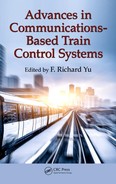
Cognitive Control for CBTC Systems ◾ 243
which can bring much more accuracy than the model with only one state transition
probability matrix. Simulation results were presented to show that the cognitive
control approach can signicantly improve the performance of train control com-
pared with other policies.
References
1. R.D. Pascoe and T.N. Eichorn. What is communication-based train control? IEEE
Veh. Tech. Mag., 4(4):16–21, 2009.
2. IEEE. Standard for communications-based train control (CBTC) performance and
functional requirements. IEEE Std 1474.1-2004 (Revision of IEEE Std 1474.1-1999),
pages 0_1–45, New York, 2004.
3. M. Heddebaut. Leaky waveguide for train-to-wayside communication-based train
control. IEEE Trans. Veh. Tech., 58(3):1068–1076, 2009.
4. L. Zhu, F.R. Yu, B. Ning, and T. Tang. Cross-layer hando design in MIMO-enabled
WLANs for communication-based train control (CBTC) systems. IEEE J. Sel. Areas
Commun., 30(4):719–728, 2012.
5. L. Zhu, F.R. Yu, B. Ning, and T. Tang. Hando performance improvements in
MIMO-enabled communication-based train control systems. IEEE Trans. Intell.
Transp. Sys., 13(2):582–593, 2012.
0 100 200 300 400 50
0
−2.0
−1.5
−1.0
−0.5
0.0
0.5
1.0
1.5
2.0
2.5
× 10
−3
Steps of Q-learning
Difference between adjacent operation policies
Figure10.17 Performance of optimization versus steps.
244 ◾ Advances in Communications-Based Train Control Systems
6. J. Huang, J. Ma, and Z. Zhong. Research on handover of GSM-R network under
high-speed scenarios. Railway Commun. Signals, 42:51–53, 2006.
7. C. Yang, L. Lu, C. Di, and X. Fang. An on-vehicle dual-antenna handover scheme for
high-speed railway distributed antenna system. In Proc. IWCMC, Chengdu, China,
September 2010.
8. L. Zhu, F.R. Yu, B. Ning, and T. Tang. Cross-layer hando design in MIMO-enabled
WLANs for communication-based train control (CBTC) systems. IEEE J. Sel. Areas
Commun., 30(4):719–728, 2012.
9. K. Rahn, C. Bode, and T. Albrecht. Energy-ecient driving in the context of a com-
munications-based train control system (CBTC). In Proc. IEEE Int’l Conf. Intelligent
Rail Transportation, Beijing, China, August 2013.
10. J. Tang and X. Zhang. Cross-layer resource allocation over wireless relay networks for
quality of service provisioning. IEEE J. Sel. Areas Commun., 25(4):645–657, 2007.
11. F.R. Yu, B. Sun, V. Krishnamurthy, and S. Ali. Application layer QoS optimization
for multimedia transmission over cognitive radio networks. ACM/Springer Wireless
Networks, 17(2):371–383, 2011.
12. B. Bu, F.R. Yu, and T. Tang. Performance improved methods for communication-
based train control systems with random packet drops, IEEE Trans. Intell. Trans.
Syst., 15(2):1179–1192, 2014.
13. S. Haykin. Cognitive Dynamic Systems: Perception-Action Cycle, Radar and Radio.
Cambridge University Press, Cambridge, UK, 2012.
14. S. Haykin, M. Fatemi, P. Setoodeh, and Y. Xue. Cognitive control. Proc. IEEE,
100(12):3156–3169, 2012.
15. R.B. Mars, J. Sallet, M.F.S. Rushworth, and N. Yeung. Neural Basis of Motivational
and Cognitive Control. MIT Press, Cambridge, MA, 2012.
16. S. Sastry and M. Bodson. Adaptive Control: Stability, Convergence and Robustness.
Dover Publications, Upper Saddle River, NJ, 2011.
17. T. Hrycej. Neurocontrol: Towards an Industrial Control Methodology. Wiley, New
York, 1997.
18. S. Haykin. Cognitive dynamic systems. Proc. IEEE, 94(11):1910–1911, 2006.
19. F. Yu, V.W.S. Wong, and V. Leung. Ecient QoS provisioning for adaptive multime-
dia in mobile communication networks by reinforcement learning. Mobile Net. Appl.,
11(1):101–110, 2006.
20. T.M. Mitchell. Machine Learning. McGraw Hill, New York, 1997.
21. S. Lin, Z. Zhong, L. Cai, and Y. Luo. Finite state Markov modelling for high speed rail-
way wireless communication channel. In Proc. IEEE Globecom’12, Anaheim, CA, 2012.
22. F. Babich, G. Lombardi, and E. Valentinuzzi. Variable order Markov modeling for
LEO mobile satellite channels. Electron. Lett., 35(8):621–623, 1999.
23. H.S. Wang and N. Moayeri. Finite-state Markov channel—A useful model for radio
communication channels. IEEE Trans. Veh. Tech., 44(1):163–171, 1995.
24. P. Sadeghi, R. Kennedy, P. Rapajic, and R. Shams. Finite-state Markov modeling of
fading channels—A survey of principles and applications. IEEE Signal Proc. Mag.,
25(5):57–80, 2008.
25. L. Zheng and D.N.C. Tse. Diversity and multiplexing: A fundamental tradeo in
multiple-antenna channels. IEEE Trans. Inform. eory, 49(5):1073–1096, 2003.
26. D. Gesbert, M. Sha, D.S. Shiu, P.J. Smith, and A. Naguib. From theory to prac-
tice: An overview of MIMO space-time coded wireless systems. IEEE J. Sel. Areas
Commun., 21(3):281–302, 2003.
Cognitive Control for CBTC Systems ◾ 245
27. IEEE. IEEE standard for information technology–telecommunications and infor-
mation exchange between systems local and metropolitan area networks–specic
requirements part 11: Wireless LAN medium access control (MAC) and physical
layer (PHY) specications. IEEE Std 802.11-2012 (Revision of IEEE Std 802.11-
2007), pages 1–2793, New York, 2012.
28. S. Su, X. Li, T. Tang, and Z. Gao. A subway train timetable optimization approach
based on energy-ecient operation strategy. IEEE Trans. Intell. Trans. Syst.,
14(2):883–893, 2013.
29. M.L. Puterman. Markov Decision Processes: Discrete Stochastic Dynamic Programming.
John Wiley & Sons, New York, 1994.
30. T.H. Xu, T. Tang, C.H. Gao, and B.G. Cai. Dependability analysis of the data com-
munication system in train control system. Science in China Series E: Technological
Sciences, 52(9):2605–2618, 2009.
31. M. Rausand and A. Høyland. System Reliability eory: Models, Statistical Methods,
and Applications. John Wiley & Sons, New York, 2004.
This page intentionally left blankThis page intentionally left blank
..................Content has been hidden....................
You can't read the all page of ebook, please click here login for view all page.
